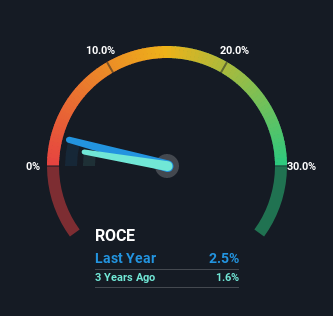- Saudi Arabia
- /
- Basic Materials
- /
- SASE:2090
We Like These Underlying Return On Capital Trends At National Gypsum (TADAWUL:2090)

Finding a business that has the potential to grow substantially is not easy, but it is possible if we look at a few key financial metrics. One common approach is to try and find a company with returns on capital employed (ROCE) that are increasing, in conjunction with a growing amount of capital employed. Put simply, these types of businesses are compounding machines, meaning they are continually reinvesting their earnings at ever-higher rates of return. Speaking of which, we noticed some great changes in National Gypsum's (TADAWUL:2090) returns on capital, so let's have a look.
Return On Capital Employed (ROCE): What is it?
Just to clarify if you're unsure, ROCE is a metric for evaluating how much pre-tax income (in percentage terms) a company earns on the capital invested in its business. Analysts use this formula to calculate it for National Gypsum:
Return on Capital Employed = Earnings Before Interest and Tax (EBIT) ÷ (Total Assets - Current Liabilities)
0.025 = ر.س12m ÷ (ر.س514m - ر.س18m) (Based on the trailing twelve months to March 2022).
So, National Gypsum has an ROCE of 2.5%. In absolute terms, that's a low return and it also under-performs the Basic Materials industry average of 6.5%.
See our latest analysis for National Gypsum

Historical performance is a great place to start when researching a stock so above you can see the gauge for National Gypsum's ROCE against it's prior returns. If you're interested in investigating National Gypsum's past further, check out this free graph of past earnings, revenue and cash flow.
What The Trend Of ROCE Can Tell Us
While there are companies with higher returns on capital out there, we still find the trend at National Gypsum promising. Looking at the data, we can see that even though capital employed in the business has remained relatively flat, the ROCE generated has risen by 39% over the last five years. So our take on this is that the business has increased efficiencies to generate these higher returns, all the while not needing to make any additional investments. On that front, things are looking good so it's worth exploring what management has said about growth plans going forward.
What We Can Learn From National Gypsum's ROCE
As discussed above, National Gypsum appears to be getting more proficient at generating returns since capital employed has remained flat but earnings (before interest and tax) are up. Since the stock has returned a staggering 193% to shareholders over the last five years, it looks like investors are recognizing these changes. In light of that, we think it's worth looking further into this stock because if National Gypsum can keep these trends up, it could have a bright future ahead.
One more thing: We've identified 3 warning signs with National Gypsum (at least 1 which is a bit concerning) , and understanding them would certainly be useful.
While National Gypsum isn't earning the highest return, check out this free list of companies that are earning high returns on equity with solid balance sheets.
Valuation is complex, but we're here to simplify it.
Discover if National Gypsum might be undervalued or overvalued with our detailed analysis, featuring fair value estimates, potential risks, dividends, insider trades, and its financial condition.
Access Free AnalysisHave feedback on this article? Concerned about the content? Get in touch with us directly. Alternatively, email editorial-team (at) simplywallst.com.
This article by Simply Wall St is general in nature. We provide commentary based on historical data and analyst forecasts only using an unbiased methodology and our articles are not intended to be financial advice. It does not constitute a recommendation to buy or sell any stock, and does not take account of your objectives, or your financial situation. We aim to bring you long-term focused analysis driven by fundamental data. Note that our analysis may not factor in the latest price-sensitive company announcements or qualitative material. Simply Wall St has no position in any stocks mentioned.
About SASE:2090
National Gypsum
Engages in the manufacture and trading of gypsum and its derivatives in the Kingdom of Saudi Arabia.
Flawless balance sheet minimal.
Similar Companies
Market Insights
Community Narratives



